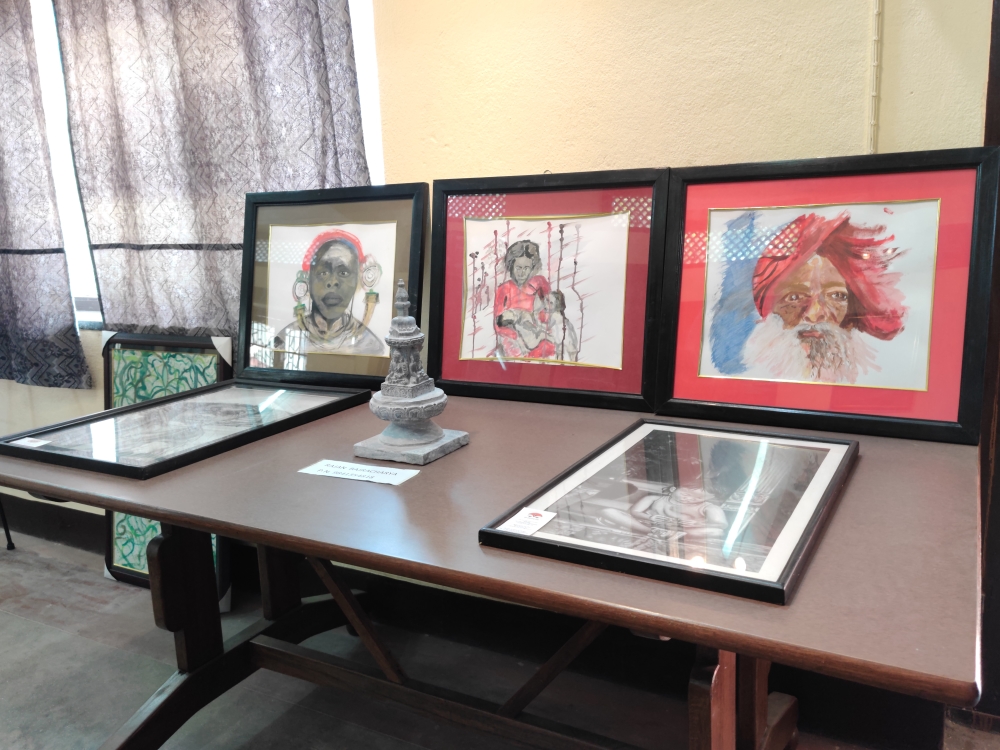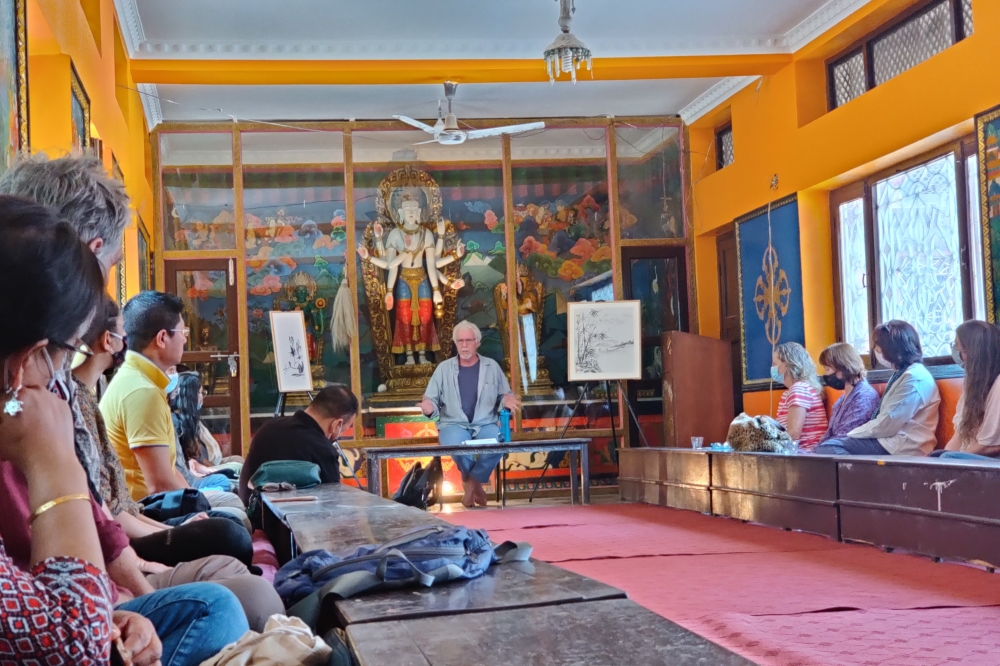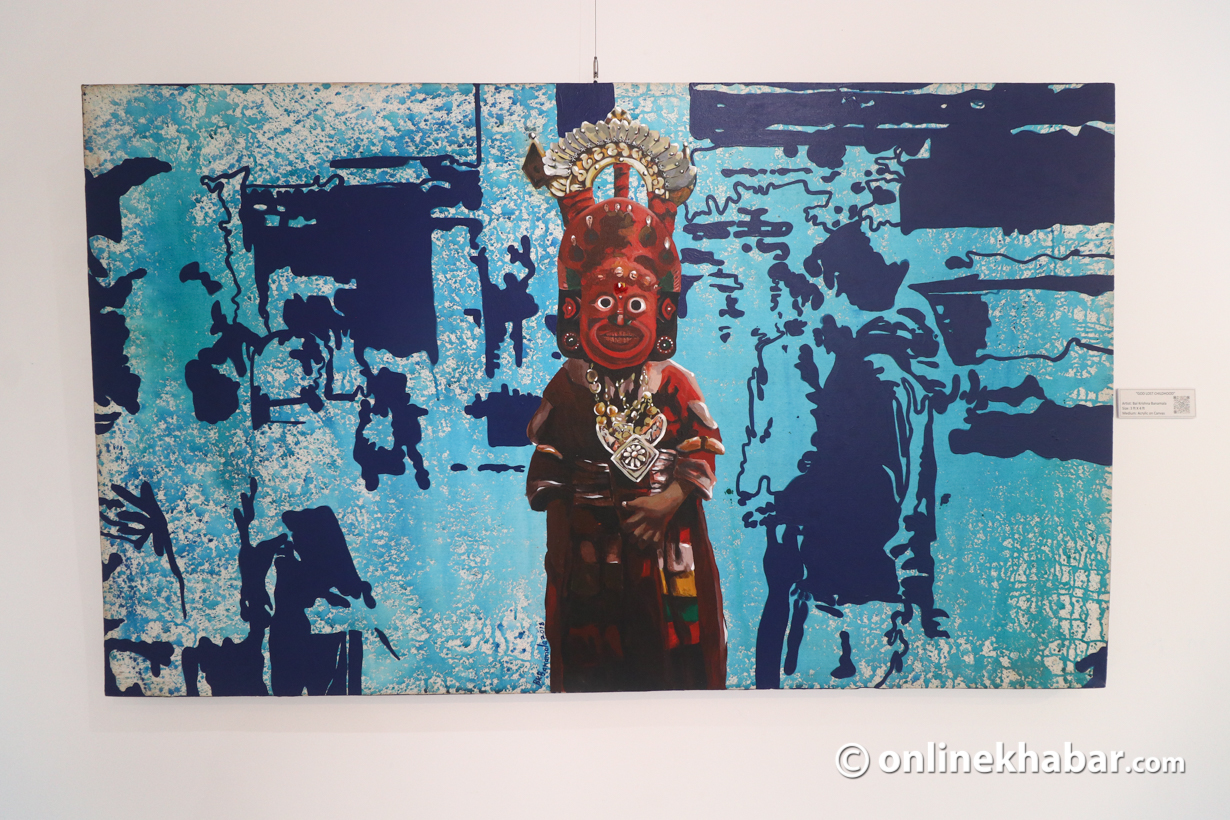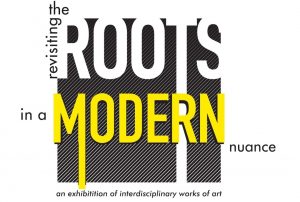Gathered at the Aksheshwar Mahavihar were a mixed group of traditional Paubha artists, contemporary artists, aspiring students, and spectators. The mass last weekend (April 9-11) witnessed a rather new kind of art exhibition, both in terms of the venue and how it was conducted.
The exhibition named Chidakash (the Space of Consciousness) was held in the courtyard of the Buddhist shrine in Lalitpur. This was an odd choice, but Aadarsha Bhattarai, the curator of the exhibition, claims the unusual and unique venue complemented the purpose of the whole exhibition to let people connect to their spiritual self.
The ‘new’ purpose

“Art is both creation and recreation.” The saying by a Chinese writer, translator, linguist and inventor Lin Yutang suggests it is the artist that chooses the position to define what art is for them.
Art has been commonly subjected to the output that one sees, but on Saturday, this particular exhibition worked with artists and found out and expressed how they want people to know it (art) is also a journey to spiritual awakening.
For this purpose, the founder of Zeroth Foundation, Bhattarai explains, “The whole exhibition was put together under five themes: bhumi (earth), hridaya (heart), manas (mind), aatmaa (consciousness) and monad (mystery). Featuring paintings and sculptures exploring human consciousness through traditional and contemporary artworks to achieve immersive experiences, the exhibition focused on both abstract and tangible art forms.”

The immersive experience Bhattarai talks about started from the venue itself. “Mahavihar as a venue came as a positive choice for us. It was unheard of, but the ambience of a vihar has been such that it has created a new kind of art experience, for us, our artists and the audience with a positive outlook.”
Exhibitions generally are thought of as space where art pieces are hung and people come and go as they please. But here, artists and the audience also got a new experience.
Mahima Singh, an artist by profession and co-founder of Bikalpa Art Centre, expresses, “The experience has been different in all senses, very immersive. As an artist myself, we can see the technical mistakes or how they could have been better. But, after the experience, what I realise is the artworks are a reflection of the artist’s state of mind while making them. So, if I had been in the state of mind as the artist, I would have seen the same results.”
Bhattarai, who is also an artist by practice, adds, “The objective of the exhibition is to tell a story and create an ecosystem to involve the audience. But to accentuate the experience, one has to go through the immersive experience. In different workshops, we hoped for people to be able to experience the art and be one with the art and the environment.”
The ‘new’ way

The days of the exhibition were divided into three parts: with yoga in the morning for the body to bring it to the state where it can experience the art without external influence. The second was yantra yoga that was achieved through the paintings for connection, used as tools to achieve enlightenment, and the third was nada yoga with which the experience and connections were established through sounds.
“Through music as well, we can achieve spiritual awakening, and a portion of this we practised here in form of Ushnishavijaya Dharani (Buddhist prayers and incantations) on the first day, Zikr (a Sufi practice) on the second, and Vedic prayers and practices on the third,” Bhattarai explains, “Just like the diverse practices coming together in one, we also want to instil that the world is one, we have to see the harmony rather than the differences for peace.”
Besides participating in the event as an artist, Bhattarai had also moderated multiple sessions there.
Each day of the yantra yoga section was divided into other diverse activities that would activate one’s imagination, encourage mindfulness, peace, and goodwill on a global scale.
Spiritual awakening through art

Many artists have been exploring and even defining art as a meditative process. The ideas were restated in the exhibition as well.
“The world today is full of anxiety and fear, be it the pandemic or our daily lives. People are more vulnerable and more susceptible to going into depression and committing suicide,” Bhattarai says, “We want art to heal them.”
Mahima Singh, another artist in the exhibition, thinks the event was successful in what Bhattarai says. “After coming to the exhibition, I realised I had been on my own journey of spiritual healing through art without knowing.”
“After losing my sister to the 2015 earthquake, I had a hard time letting her memories go, and be happy even. Either by talking to those who went through the same kind of pain or by exploring different avenues of art, what I was doing, I finally realised, I was able to heal myself from the pain,” Singh narrates, “I made a portrait of her with washable paints and immersed the portrait in the water. As the colours washed away in the water, I let go of my pain of the loss as well.”
French artist Jerome Edou, speaking in a discussion about consciousness during the event, also expresses that enlightenment through art is possible. “Art is about the spiritual journey of one connecting to oneself, in one’s own nature, using brush and strokes.”
Bhattarai shares, “Art for me is new and raw. I walked into a gallery in the US where I saw a Chaturbhuj Mahakaal painting that drew me in; its magnificence was such that I decided to leave everything there and come back here to pursue art. I learned the art then and have been exploring it ever since. My art is my philosophical journey for peace that comes straight from the heart.”
For artists to experience spiritual awakening through art, Edou adds, “Art should be done without intention to impress, to make it nice, beautiful. Art should be in its simplest form bringing silence and music together, bringing forms and emptiness together. And it should be without the intention to reproduce anything.”
After Lalitpur, the art exhibition is scheduled to hold similar exhibitions in fiver other places in Kathmandu, Bhaktapur, Lumbini, Pokhara, and Dhulikhel.
























